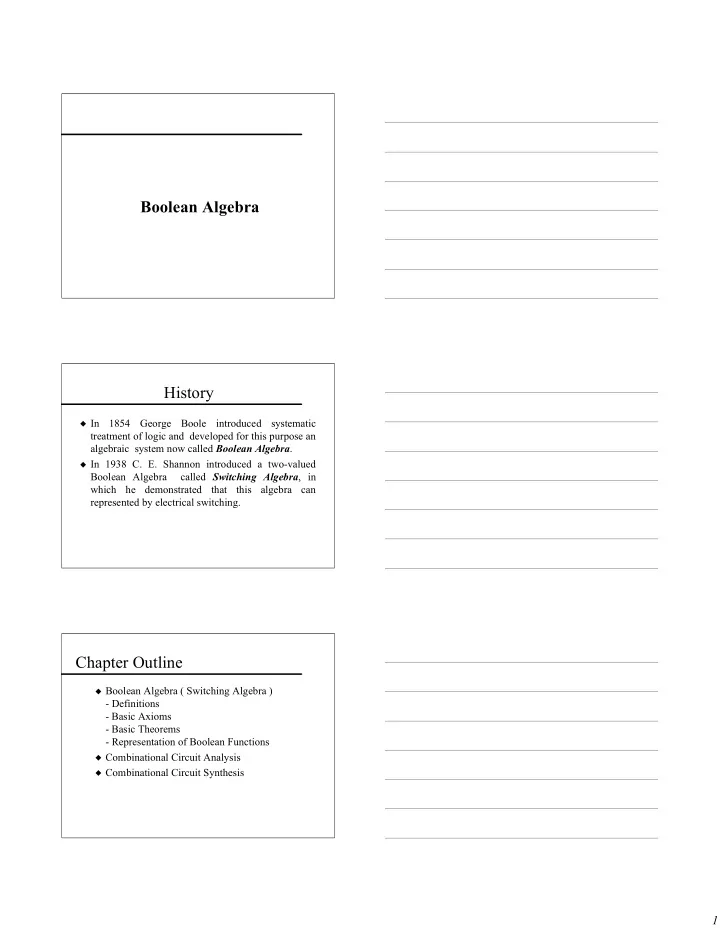

Boolean Algebra History ◆ In 1854 George Boole introduced systematic treatment of logic and developed for this purpose an algebraic system now called Boolean Algebra . ◆ In 1938 C. E. Shannon introduced a two-valued Boolean Algebra called Switching Algebra , in which he demonstrated that this algebra can represented by electrical switching. Chapter Outline ◆ Boolean Algebra ( Switching Algebra ) - Definitions - Basic Axioms - Basic Theorems - Representation of Boolean Functions ◆ Combinational Circuit Analysis ◆ Combinational Circuit Synthesis 1
Boolean Algebra Definitions Definitions ◆ Boolean Algebra : An algebraic structure defined with a set of elements B={0,1}, a set of binary operators ( + , . , ‘ ), and a number of unproved axioms. ◆ Symbolic variables such as X, Y , Z represent the elements. A variable can take the value “0” or “1” which corresponds to the condition of a logic signal. ◆ Algebraic operators : - Addition operator ( + ) - Multiplication operator ( . ) - Complement operator ( ‘ ) Basic Axioms ◆ A variable can take only one of two values{0,1} ( A1 ) X= 0 if X ≠ 1 ( A1’ ) X=1 if X ≠ 0 ◆ NOT operation ( The complement Operation ) : ( A2 ) If X=0 then X’=1 ( A2’ ) If X =1 then X’=0 ◆ AND and OR operations ( Multiplication and Addition) : ( A3 ) 0 . 0 = 0 ( A3’) 0 + 0 = 0 ( A4 ) 1 . 1 = 1 ( A4’) 1 + 1 = 1 ( A5 ) 0 . 1 = 1 . 0 = 0 ( A5’) 1 + 0 = 0 + 1 = 1 2
Generalized Demorgan’s Theorem ◆ (T14)[F(X1,X2, ... , Xn,+, . )]’= F(X1’,X2’,...,Xn’, . ,+) ◆ Example : F= (X1.X2)+(X2+X3) X1 F’= [(X1.X2)+(X2+X3)]’ X2 X3 X1 F’= (X1’+X2’).(X2’.X3’) X2 X3 Duality ◆ Duality : Every Boolean expression remains valid if the (AND, OR) operators and {0,1}elements are interchanged. ◆ Mathematical definition : F is a Boolean Function , FD the dual function is : FD(X1,X2, ... , Xn, + , . ,’ ) def as F( X1,X2,....,Xn, . ,+ ,’) ◆ FD ≠ F Theorem 3
Representation of Logic Functions ◆ Truth table with 2^n rows, n: the number of variables ◆ Definitions : - Literal : a variable or its complement Example : X , Y’ - n- variable minterm : product term with n literals Example : X’.Y.Z - n- variable maxterm : sum term with n literals Example : X+Y’+Z Truth Table ◆ Example : F( X, Y , Z ) Row X Y Z F Minterms Maxterms 0 0 0 0 0 X’.Y’.Z’ X +Y +Z 1 0 0 1 1 X’.Y’.Z X +Y +Z’ 2 0 1 0 0 X’.Y .Z’ X +Y’+Z 3 0 1 1 1 X’.Y .Z X +Y’+Z’ 4 1 0 0 0 X .Y’.Z’ X’+Y+Z 5 1 0 1 0 X .Y’.Z X’+Y+Z’ 6 1 1 0 1 X .Y .Z’ X’+Y’+Z 7 1 1 1 0 X .Y. Z X’+Y’+Z’ Canonical Representation : ◆ Canonical Sum ( Sum of Products- SOP ): Sum of minterms corresponding to input combinations for which the function produces a 1 output. - Example : F = X’.Y’.Z + X’.Y.Z + X.Y.Z’ F X,Y,Z = Σ(1, 3 , 6 ) ◆ Canonical Product ( Product Of Sums-POS ): Product of maxterms corresponding to input combinations for which the function produces a 0 output. - Example : F = (X+Y+Z).(X+Y’+Z).(X’+Y+Z).(X’+Y+Z’).(X’+Y’+Z’) F X,Y,Z = Π (0,2,4,5,7 ) 4
Recommend
More recommend